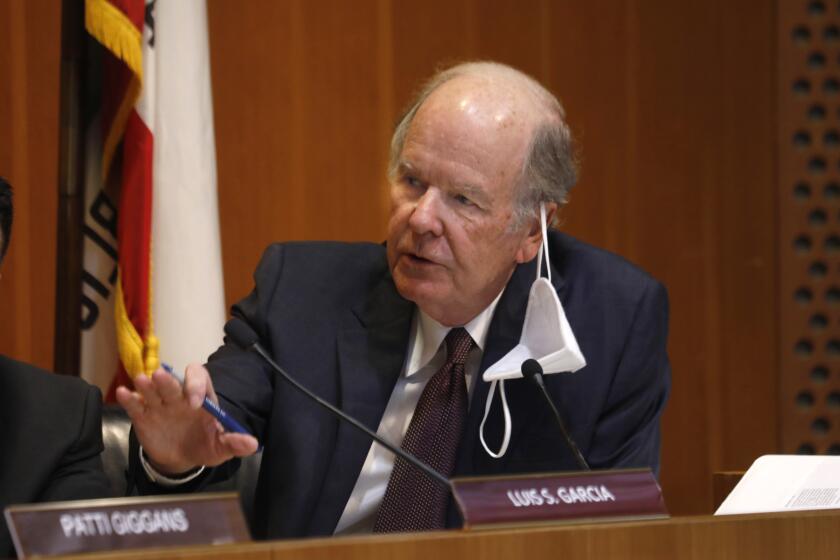A look at Proposition 13, the $15-billion school bond on the March 3 ballot
- Share via
SACRAMENTO — California voters will see only one statewide proposition on the March 3 primary ballot, a proposal to borrow money for the state’s schools. And in an election season dominated by a fiercely contested Democratic presidential race, this single ballot measure has received little attention.
But Proposition 13 has major implications for school campuses across the state, its supporters say. And while a slim majority of voters in several polls have said they support the proposal, that may largely be due to a tendency to say yes: Only once in the past quarter-century has a statewide K-12 education bond been defeated.
This year’s proposal, though, would help more than just those schools. And it asks voters to approve more than just borrowing money.
$15 billion in borrowing for school construction
The main focus of Proposition 13 is simple: It proposes the sale of $15 billion in general obligation bonds to finance construction projects for K-12 schools, community colleges and state universities.
It’s important to note that, like any loan, the $15 billion must be paid back over time with interest. The independent Legislative Analyst’s Office estimates Proposition 13 will cost taxpayers an additional $11 billion in interest payments by the time all is said and done. That makes it a $26-billion proposal, paid in annual installments of about $740 million for 35 years.
The largest slice of Proposition 13 bond funds — $5.2 billion — would be earmarked for renovating existing, older buildings at primary and secondary schools across California. An additional $2.8 billion would be reserved for new school construction. Facility needs at career technical education sites and charter schools would evenly split $1 billion more in bond funds.
Another $6 billion will be evenly split among the University of California, California State University and community college systems. The language of Proposition 13 prioritizes spending on seismic upgrades on college campuses as well as the removal of hazardous materials such as mold and asbestos.
The ballot measure gives preference in some of the K-12 bond money to smaller schools. It also includes the testing and treating of lead found in school water supplies as the kind of project eligible for financial assistance. And overall, Proposition 13 sets a cap of $750 million in bond funds that can be spent on administrative costs.
New rules on who gets money, a boost for union projects
Proposition 13 offers additional state help to local schools that have less ability to raise matching bonds for construction projects, and for those serving more English learners, foster youth and students from low-income families. In these cases, the state could cover as much as 55% of the costs of new buildings and 65% of renovation efforts.
The ballot measure also changes traditional “first come, first served” rules about doling out school bond dollars. Projects impacting the health and safety of students would have the highest priority, followed by those from projects with limited local options.
A provision tucked inside the legislation that put Proposition 13 on the ballot also boosts organized labor, a powerful constituency for Democrats in the California Legislature. Projects meeting the above hardships will be given additional preference for bond funds if they include a “project labor agreement,” a promise to use construction workers who belong to a union.
New rules for local school borrowing
One unique provision of this election’s Proposition 13 has caused some confusion — perhaps, in part, by what some voters remember about the other Proposition 13, the iconic 1978 ballot measure that limits property taxes.
School construction projects are financed through a combination of state and local bond measures. For local school bonds, the total amount of borrowing is limited by the assessed value of all property within a school district. Elementary and high school districts can borrow only an amount equal to 1.25% of local property values, while larger unified school districts and community college districts can sell bonds only in a value equal to 2% of their community’s property values. None of this affects the way property values are established or the actual taxes imposed — the key components of the 1978 tax initiative.
The school bond on the March 3 ballot seeks to loosen these limits on local school borrowing. It would allow elementary and high school districts to borrow up to 2% of the assessed value of nearby properties while giving unified school districts and community colleges permission to sell local bonds equal to 4% of local property values.
It’s easy to see how this would be confusing. After all, the 1978 tax-limiting initiative involves strict rules about how property values are set and the general tax levy that can be imposed. The new school bond doesn’t change any of that, but it does use those property values in its effort to allow schools to issue more local bonds.
And, of course, those bonds have to be paid back by local residents. It may not be a tax, by the strictest of definitions, but it’s still money owed to fund government services.
More to Read
Sign up for Essential California
The most important California stories and recommendations in your inbox every morning.
You may occasionally receive promotional content from the Los Angeles Times.














